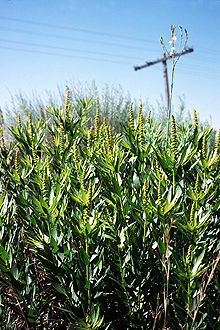Stillingia sylvatica
| Stillingia sylvatica | ||||||||||||
|---|---|---|---|---|---|---|---|---|---|---|---|---|

Stillingia sylvatica |
||||||||||||
| Systematics | ||||||||||||
|
||||||||||||
| Scientific name | ||||||||||||
| Stillingia sylvatica | ||||||||||||
| L. |
Stillingia sylvatica is a species of the genus Stillingia . In their homeland it is called queen's root, queen's delight and yaw root in Englishand is also traded as “Stillingia treculeana”. It occurs naturally in the southeastern United States and is used as a medicinal plant.
description
Stillingia sylvatica grows as a more or less upright subshrub that reaches a height of 20 to 120 cm. It has a woody rhizome . The roots are thickened spindle-shaped. The branches arise individually or in groups from the rhizome, they are unbranched or dichotomously branched in the upper area . They are round stem and remain herbaceous or slightly woody. Older shoot axes have a reddish, reddish-brown or gray-reddish speckled bark , which often has longitudinal and transverse cracks.
The alternate leaves are stalked or sessile. With a length of 2 to 12 cm and a width of 0.3 to 4.8 cm, the simple, membranous leaf blade is variable in shape between narrow elliptical, elliptical, obovate to obovate or spatulate. The leaf blade ends pointy, rounded or with an edged tip. The leaf base is wedge-shaped or blunt, the leaf edge finely serrated or notched.
Stillingia sylvatica is single sexed ( monoecious ). The flowering period extends from March to June. The inflorescence measures a total of 2.5 to 13 cm, it is composed of numerous zymous partial inflorescences arranged in a spiral on the inflorescence axis, of which the lower female, the upper male flowers . The partial inflorescences are in the axilla of a bract , which is broadly elliptical to long in the female flowers and broadly elliptical in the male partial inflorescences. The color of the bracts and the inflorescence axis is red or yellow-green. The male partial inflorescences contain five to thirteen flowers that are 1.5 to 2 mm in size. Female flowers have three bracts that are 2 to 3 mm in size. The ovary is three-chambered.
The 0.6 to 1.2 cm large capsule fruits are slightly three-lobed. The fruits develop from April to September. The seeds are ellipsoidal with a length of 4 to 8 mm and a diameter of 3 to 7 mm.
distribution
Stillingia sylvatica occurs in the south and southeast of the United States. The plants grow in sparse pine forests on acidic sandy soil.
Taxonomy and systematics
The first publication of Stillingia sylvatica took place in 1767 by Carl von Linné in Mantissa Plantarum . Impensis Direct. Laurentii Salvii, p. 126. The specific epithet sylvatica means “belonging to the forest”, so it relates to the location.
Two subspecies can be distinguished:
- Styllingia sylvatica L. subsp. sylvatica : The leaf blade is elliptical, spatulate or obovate with a length of 3.2 to 11.5 centimeters and a width of 0.3 to 4.8 centimeters and ends pointed, blunt or with margins. The bracts of the female partial inflorescences are elliptical. The distribution of this subspecies coincides with that of the species, with the exception of southeast Florida.
- Styllingia sylvatica subsp. tenuis (Small) DJRogers (Basionym Styllingia tenuis Small ): The leaf blade is very narrow elliptical to linear with a length of 2 to 10 centimeters and a width of 0.3 to 1 centimeter and ends with a point. The bracts of the female partial inflorescences are tail-pointed. This subspecies has a small range on the southeast coast of Florida, where it grows on limestone.
In addition to the two subspecies, variable forms arise through hybridization with Stillingia texana (these hybrids, in contrast to Stillingia sylvatica subsp. Sylvatica, also grow on calcareous soils ) and with Stillingia aquatica .
use
The root of Stillingia sylvatica is traditionally used by the Indians of the southern USA against syphilis and other diseases. A tincture made from the fresh or dried roots is used.
It has recently also found its way into healing practice. Numerous preparations are offered. However, there are no studies that prove a healing effect. Known side effects are dizziness, diarrhea, sweating, nausea, muscle pain, itching, rashes, coughing, and vomiting.
It also contains diterpene esters, which can cause irritation to the mucous membranes and skin.
Individual evidence
- ^ Memorial Sloan-Kettering Cancer Center (Ed.): About Herbs, Botanicals & Other Products: Stillingia sylvatica , Trivialnames
- ↑ a b c d e f g David James Rogers: A revision of Stillingia in the new world . In: Annals of the Missouri Botanical Garden . tape 38 , no. 3 , 1951, pp. 239-243 ( (online) ).
- ↑ Carl von Linné : Mantissa Plantarum. Impensis Direct. Laurentii Salvii, 1767, p. 126 (PDF file).
- ^ Memorial Sloan-Kettering Cancer Center (Ed.): About Herbs, Botanicals & Other Products: Stillingia sylvatica , Side Effects
- ^ Memorial Sloan-Kettering Cancer Center (Ed.): About Herbs, Botanicals & Other Products: Stillingia sylvatica , Warnings
